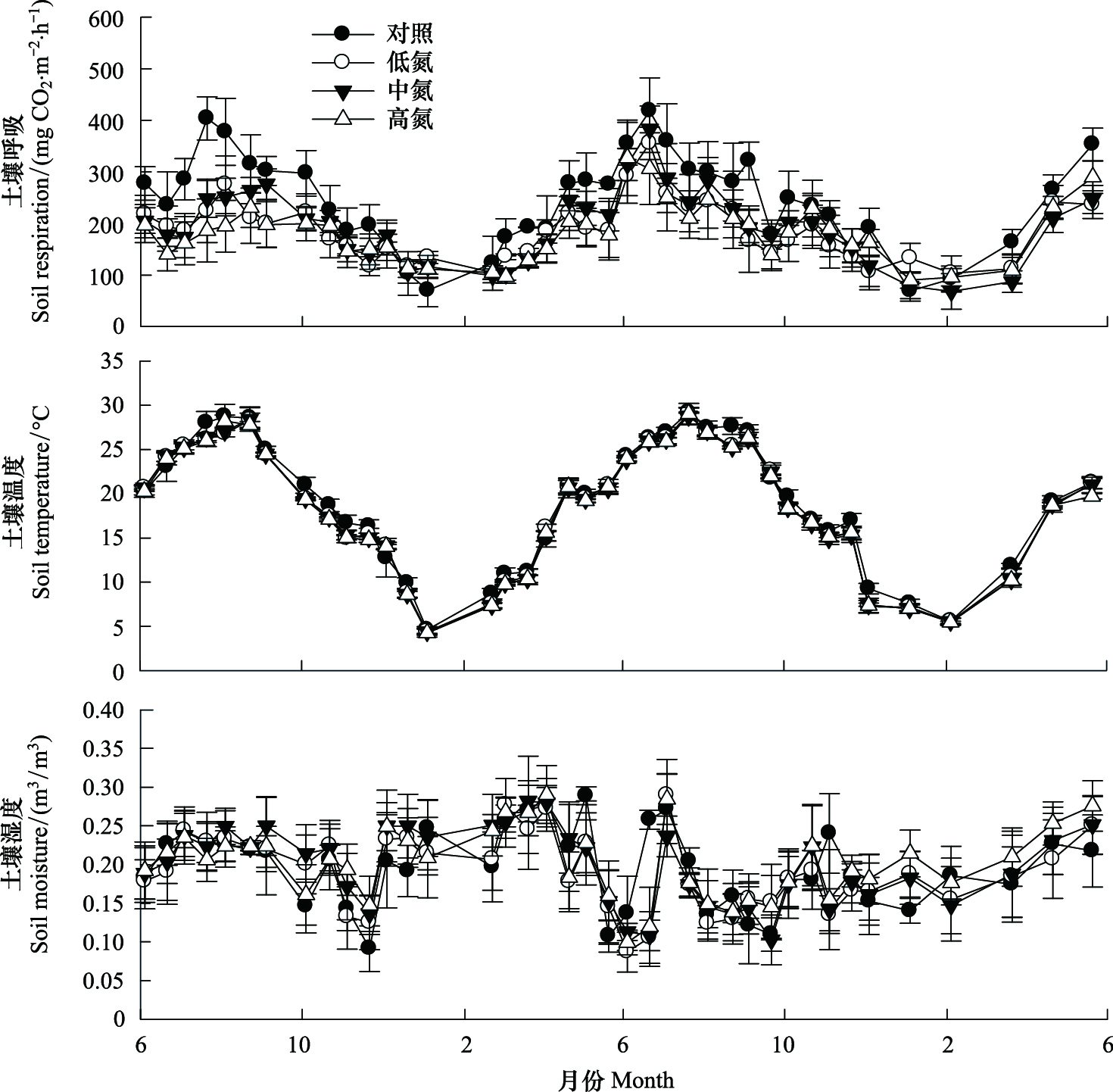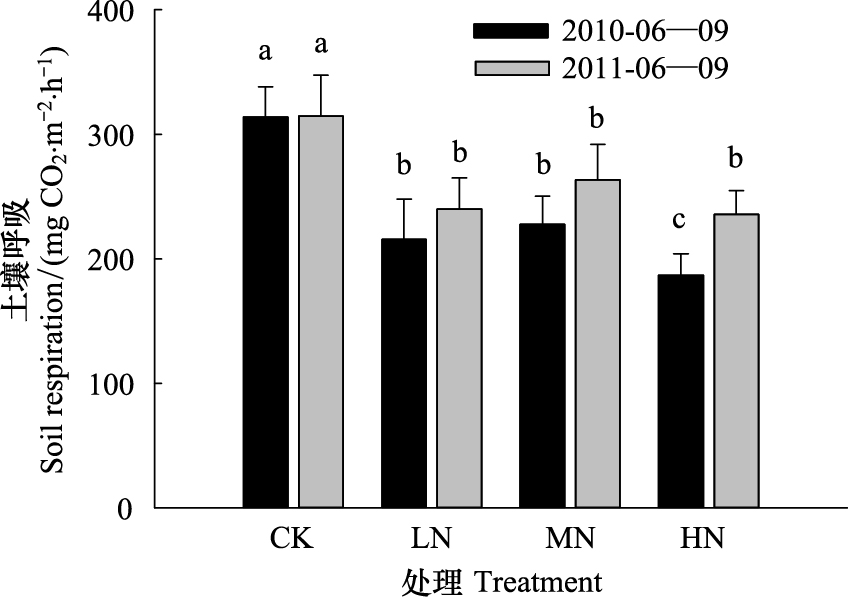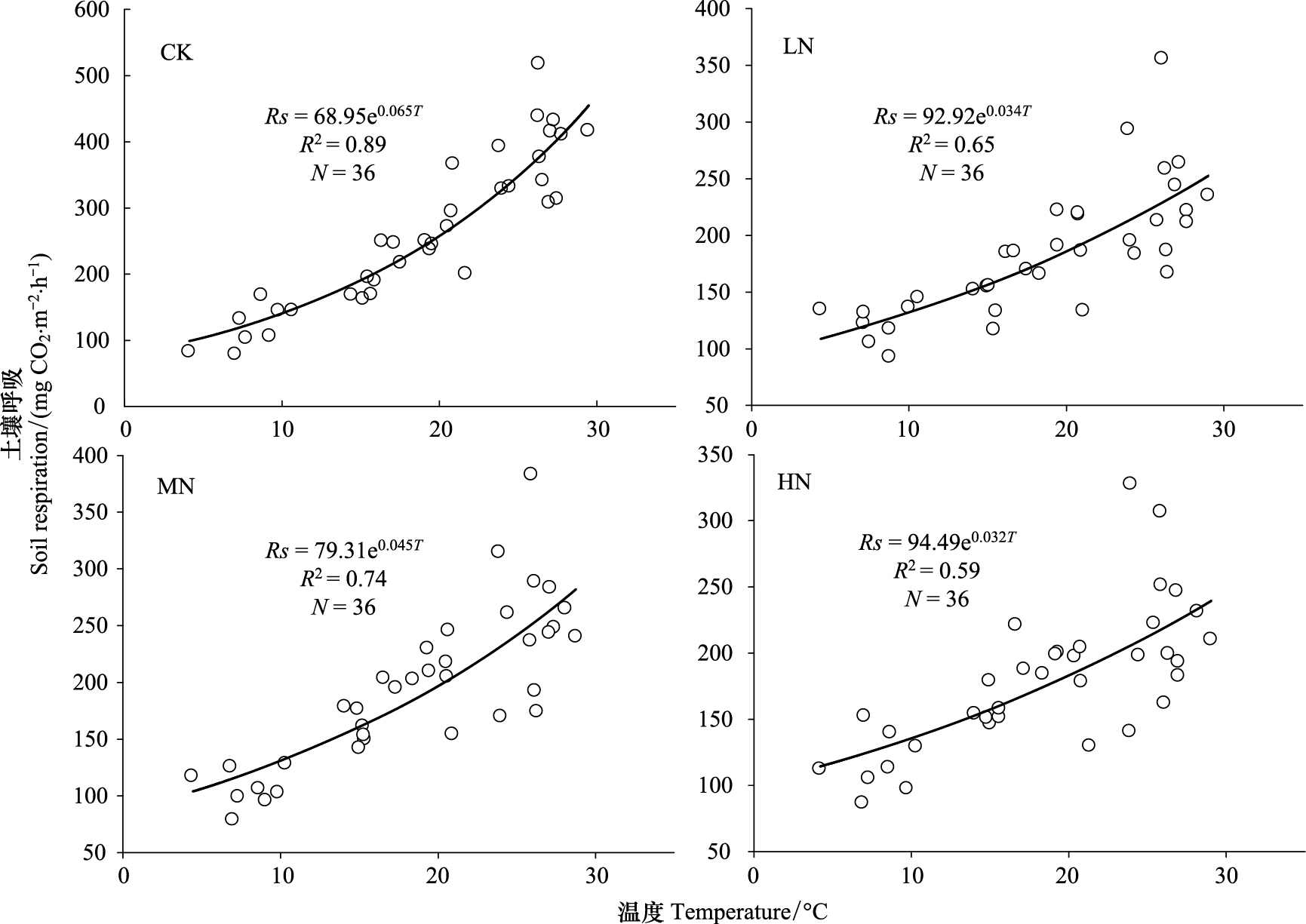文章信息
- 刘益君, 闫文德, 郑威, 王光军, 张徐源, 梁小翠, 高超
- LIU Yijun, YAN Wende, ZHENG Wei, WANG Guangjun, ZHANG Xuyuan, LIANG Xiaocui, GAO Chao
- 施氮对湿地松(Pinus elliottii)林土壤呼吸和相关因子的影响
- The effect of nitrogen addition on soil respiration and associated factors in Pinus elliottii forest
- 生态学报, 2016, 36(2): 342-349
- Acta Ecologica Sinica, 2016, 36(2): 342-349
- http://dx.doi.org/10.5846/stxb201311192767
-
文章历史
- 收稿日期: 2013-11-19
- 网络出版日期: 2015-06-10
2. 广西壮族自治区林业科学研究院, 南宁 530002;
3. 城市森林生态湖南省重点实验室, 长沙 410004;
4. 南方林业生态应用技术国家工程实验室, 长沙 410004
2. Guangxi ForestryResearchInstitute, Nanning 530002, China;
3. Key Laboratory of Urban Forest Ecology of Hunan Province, Changsha 410004, China;
4. National Engineering Laboratory for Applied Technology of Forestry & Ecology in South China, Changsha 410004, China
近几十年来,氮肥施用和氮沉降增加了森林生态系统的氮输入,提高了许多森林的氮素利用水平,给全球森林生态系统带来不同的影响。在氮素限制的生态系统,适量的氮输入会刺激森林生产的提高;但过量的氮输入则会带来等氮淋溶、土壤酸化、营养失衡等多种危害[1],因而,氮素对生态系统的影响成为当前的研究热点。
土壤呼吸是全球碳循环中CO2从陆地生态系统至大气的主要途径[2],为第二大陆地碳通量[3],10倍于化石燃料所释放CO2[4],在全球碳循环过程有着重要地位。土壤呼吸很大程度上受土壤温度[5]、土壤湿度[6, 7]及基质供应[8]所控制,氮素可通过影响植物生长[9]、微生物特性、凋落物分解(-38%—64%)[10]、根系活动等,改变土壤呼吸温度敏感性[5, 11]、土壤水分可利用性[12]及碳供给(地下生物量和凋落物)[13]等,引起土壤呼吸的变化,影响森林碳循环过程。
氮添加试验是目前研究高氮输入对土壤呼吸及相关因子影响的常用方法,但在不同生态系统和地区所得结论存在差异。Deng等[14]及Cleveland等[15]的研究均发现氮添加促进土壤呼吸,而Cusack等发现施氮抑制土壤呼吸[16];同时,土壤呼吸不受施氮影响[17]的结论也有出现。土壤呼吸对施氮响应迥异的原因可能在于环境因子的差异及养分限制因子的不同[15]。北美、欧洲的施氮实验开展较早[5],但主要集中在温带森林生态系统响应及机理[18],热带、亚热带森林的相关研究起步较晚。近年来,我国陆续开展了多个氮添加试验,对不同地区的多种森林类型对高氮输入的响应进行了研究。本研究选取我国亚热带地区广泛分布的湿地松人工林为对象,开展人工氮添加实验。目的在于确定高氮输入对亚热带湿地松林土壤呼吸及相关因子的影响;探究该区域湿地松林的氮输入承载水平,为评估我国亚热带地区的碳循环提供依据。
1 试验地概况试验地位于湖南省天际岭国家森林公园(113°01′—113°02′E,28°06′—28°07′N),面积约4356hm2,海拔46—114m,坡度5°—25°。年平均气温17.2℃,1月平均气温4.7℃,7月平均气温29.4℃;无霜期为270—300d,年均日照时数1677.1h;年平均降雨量1422mm,6—9月份降雨量占全年降雨50%左右,属典型的亚热带湿润季风气候。土壤为典型红壤,全氮含量为(1.34±0.05)mg/g,有机碳为(16.04±2.24)mg/g,pH为4.01±0.17。当地无机氮湿沉降量为3.14gm-1a-1,NH4-N/NO3-N约为6∶4[19]。2009年4月调查的林分基本情况见表 1。
|
树种 Species | 树龄 Age(Year) | 密度 Stem density/(株/hm2) | 胸径 DHB/cm | 树高 Height/m | 断面积 Basal area/(m2/hm2) | 全氮 Total Nitrogen/(mg/g) | 有机碳 Organic carbon/(mg/g) | pH |
|
湿地松 Pinus elliottii | 35 | 600 | 22.92(0.42) | 21.37(1.03) | 22.10 | 1.34(0.05) | 16.04(2.24) | 4.01(0.17) |
| 樟树 Cinnamomum camphora | 10 | 360 | 7.91(0.39) | 8.35(0.23) | 2.96 | |||
| 山矾 Symplocos caudata | 11 | 600 | 7.99(0.19) | 6.12(0.17) | 4.12 | |||
| 其他 Others | 14 | 310 | 10.21(0.84) | 11.21(1.01) | 3.19 | |||
| 括号内为标准误差 | ||||||||
采用NH4NO3进行氮添加处理,参考同类研究[15, 20],共设置4个氮添加水平:CK(无N添加),LN(5gNm-2 a-1)、MN(15gNm-2 a-1)、HN(30gNm-2 a-1),每一水平设3个重复样方(10m×10m),样方间保留5m宽缓冲带防止干扰,样方设置时检验所设置样方的理化性质的均匀性。将每个样方需要施入的NH4NO3溶入20L水中,用喷雾器均匀喷洒至样方,CK样地仅施加等量自来水。在每年干湿交替季的5月、10月分两次等量施加[15]。首次施氮时间为2010年5月。
2.2 土壤呼吸、温度及湿度的测定在每个样方随机选择3个测定点安放PVC连接环(Φ21cm×H8cm),环插入土壤4cm左右,测量期间环不再移动。2010年6月至2012年1月,半月1次测定土壤呼吸(雨天则延至晴天日)。土壤呼吸采用LI-8100(Li-CORInc.,Lincoln,NE,USA)测定;5cm处土壤温度、湿度测定与土壤呼吸速率测定同步进行,采用Li-COR-8100通量系统配套的温、湿度探针Li-8100-201Omega、Li-8100-202测定。同时在样地内设置3台EM50数据采集器接驳ECH2O-5TE监测5cm处土壤温湿度,测定间隔为30min。
2.3 土壤细根生物量,土壤微生物碳、氮测定2012年4月进行细根生物量和微生物碳、氮的测定。细根生物量采用土钻法采集,在每个样地中以梅花形取点,各点3钻合一,取土深度为20cm,土钻内径为10cm。挑取≤2mm细根,烘干求得细根生物量。土壤微生物碳、氮测定,从根钻余土中称取过2mm筛土样10g,进行氯仿熏蒸,采用40mL 0.5mol/L K2SO4溶液300r/min震荡30min浸提,过滤后采用德国耶拿TOCMultiN/C3100总碳-总氮分析仪进行测定。土壤碳、氮和pH分别采用重铬酸钾外加热法、半微量凯氏定氮法和电位法测定。
2.4 凋落物生物量测定在各施氮水平每个重复样方内分别安置2块凋落物收集网,孔眼为1mm×1mm,凋落物收集网面积为2m×2m,悬挂于距地面0.5m处,共计4×3×2=24张收集网。2010年8月至2011年10月,每月收集凋落物,烘干求得生物量。
2.5 数据统计分析采用SPSS软件进行单因素方差分析,LSD多重比较检验不同处理间土壤呼吸、温度、湿度、细根生物量、凋落物、微生物碳氮的差异性,显著性水平α=0.05。采Sigmaplot软件作图。采用指数方程拟合土壤呼吸与温度的关系:R=αexp(bT),R为土壤呼吸,α是土壤温度为0℃时的土壤呼吸速率,b为温度反应系数[21]。土壤呼吸温度敏感性采用Q10值:Q10=exp(10b)[22],b为温度反应系数。土壤呼吸年累积量利用ECH2O所监测土壤温度数据代入土壤呼吸与温度回归方程,以日为时间步长计算得出。
3 结果与分析 3.1 施氮对土壤年呼吸量的影响施氮对土壤呼吸产生了显著的抑制作用。研究期间,CK处理的土壤年呼吸量为1.97×104kg/hm2,LN、MN和HN处理的为1.53×104、1.59×104kg/hm2和1.49×104kg/hm2,施氮处理分别较CK处理显著降低了22.1%、19.7%和24.5%。HN处理的土壤呼吸小于LN和MN处理的,但它们之间的土壤呼吸无显著差异。
施氮处理第1年的林分生长期间(6—9月),LN、MN和HN处理的土壤呼吸分别较CK样地的降低了31.3%、27.4%和40.4%;第2年相对应的值分别为24.0%、16.5%和25.3%。表明在CK处理土壤呼吸差异不大的情况下,施氮的抑制作用第1年要明显大于施氮的第2年。
3.2 施氮对土壤呼吸季节性变化的影响各施氮处理下,湿地松林土壤呼吸存在明显的季节性波动(图 1)。土壤呼吸在冬季较低,最小值出现在1月(99.12mg CO2 m-2 h-1);随后,土壤呼吸持续增加,在夏季较高,并在8月期间达到最大值(356.32 mg CO2 m-2 h-1)之后,土壤呼吸逐渐降低。施氮处理并未改变湿地松林土壤呼吸的季节性变化规律。

|
| 图 1 土壤呼吸和土壤温度的季节动态(测定时间为2010年6月至2012年5月) Fig.1 Seasonal patternof soil respiration and soil temperatureat 5 cmdepth (Soil respiration was meas ured from June 2010 to January 2012) |
从土壤温度的年均值来看,对照处理为18.81℃,高于LN、MN和HN处理的18.45℃、18.28℃和18.34℃,但在实验期内的各次测定日,施氮处理下的土壤温度与对照处理均没有显著差异。各处理组土壤湿度在测定日无显著性差异,CK、LN、MN和HN处理的土壤湿度年均值为0.197、0.192、0.199和0.202。土壤温度的季节变化趋势与土壤呼吸相同(图 1)。5cm处土壤温度与各处理土壤呼吸间均存在极显著正相关性(表 2),其相关系数范围为0.466—0.522;除CK外,土壤湿度与土壤呼吸间也存在显著正相关性(表 2),相关系数范围为0.139—0.181。采用各处理重复样点的均值建立土壤呼吸与土壤温度的回归方程,各处理5cm处土壤温度与土壤呼吸的单因素指数回归方程(图 3)可得:土壤温度解释了土壤呼吸速率的65.40%—88.79%,5cm土壤温度为土壤呼吸的主要驱动因子。
| 呼吸速率Respiration rates | 因子Factors | 相关系数RCorrelationcoefficientR | |||
| CK | LN | MN | HN | ||
| R | T | 0.501** | 0.466** | 0.566** | 0.522** |
| M | 0.038 | 0.139** | 0.181** | 0.138** | |
| R:土壤呼吸Seasonal soil respiration; T:5cm处土壤温度Soil temperatureat 5cm depth; M:5cm处土壤湿度Soil moisture 5cm; Pearson相关分析,双侧检验; **表示极显著相关 | |||||

|
| 图 2 2010年和2011年6—9月土壤呼吸均值 Fig.2 Mean soil respiration rates during June to September in year 2010 and year 2011 不同字母表示处理间存在显著性差异 |

|
| 图 3 土壤呼吸与5cm处土壤温度的关系(土壤温度、土壤呼吸速率为各次测定重复值的平均) Fig.3 Relationships between soil respiration and soil temperature at 5cm depth (soil temperature and soil respiration rates are the mean value of repeats) |
Q10值反映了土壤呼吸对温度变化的敏感性。通过土壤呼吸与5cm处土壤温度的指数方程计算得到CK、LN、MN、HN处理的Q10值分别为1.91、1.40、1.56、1.38,施氮处理明显降低了土壤呼吸的温度敏感性。
3.4 施氮对年凋落物量和土壤细根生物量的影响施氮对湿地松林年凋落量存在抑制作用。LN、MN、HN处理的年凋落量为404.92、413.87、403.94g/m2,分别较CK(520.72g/m2)低22.2%、20.5%、22.4%,且与CK差异显著(图 4)。施氮对细根生物量也存在一定的抑制作用,LN、MN、HN处理的0—20cm处的细根生物量均小于CK,但差异均未达到显著(图 4)。

|
| 图 4 各处理凋落物和细根生物量 Fig.4 Comparisons of litterfall, Fine root biomass among N treatments in slash pine forest 凋落物测定时间为2010年8月至2011年10月,细根生物量采样时间为2010年10月,采样深度0—20cm |
施氮对湿地松林土壤微生物C、N均存在明显的抑制作用(图 5)。2012年4月的测定结果表明LN、MN、HN处理的微生物碳量为256.99、238.55、193.20mg/kg,分别较CK(315.99mg/kg)低18.7%、24.5%、38.9%,且差异显著。LN、MN、HN处理的微生物氮量分别较CK处理低15.3%、28.8%、38.9%,其中,MN、HN处理与CK处理差异显著。

|
| 图 5 各处理土壤微生物碳、氮(测定时间为2012年4月,测定土层为0—10cm) Fig.5 Soil microbial biomass in plots accepted different nitrogen addition level(Measuredin April 2012,soil depth was 0—10cm) 不同字母表示处理间存在显著性差异 |
本研究中,施氮显著抑制了湿地松林分的土壤呼吸。平均而言,LN,MN和HN处理分别比CK处理显著降低了土壤呼吸约22%、20%和25%。这个结果与其他一些学者的研究结果相相似[23]。比如,Lee和Jose[24]报道在美国佛罗里达一块美国黑杨(Populus deltoides Marsh)林分中,施氮处理使土壤呼吸降低了5%—18%。Mo等[5]在我国鼎湖山一块热带成熟林开展了增加氮输入对土壤呼吸影响的试验,他们发现低,中氮的处理(5—10gNm-2 a-1)未显著改变土壤的年呼吸速率,而高氮输入则降低土壤年呼吸速率的14%。土壤呼吸通常是由土壤的自养呼吸(主要为根呼吸)和异养呼吸(主要为微生物呼吸)所组成[25]。而在本研究中,施氮减少了林分凋落物量和细根生物量,降低了土壤中微生物碳量(19%—39%)和微生物氮量(15%—39%),所以,就不难理解本文的试验中施氮处理导致土壤呼吸下降的原因。实验期内施氮处理显著的抑制了湿地松林的土壤微生物碳氮量(图 5),意味着土壤微生物的数量和活性均降低,将直接造成土壤微生物呼吸的下降[24]。土壤微生物呼吸一般占土壤呼吸的20%—80%[23],而在相同试验地杉木人工林土壤呼吸的研究中发现,土壤微生物呼吸占土壤总呼吸的69%—76%[27, 28]。本试验中施氮处理的湿地松林分的凋落物量均有显著减少(在20%以上)(图 4),这不仅使得呼吸底物数量的下降,直接降低土壤呼吸,而且还减少了凋落物中的碳通过分解、淋溶进入土壤,造成进入土壤的碳源减少,导致土壤微生物的能量和营养源的减少,势必引起土壤总呼吸量的减少。
植物根系通过自身的呼吸(自养呼吸),根分泌物和死根的归还来影响土壤呼吸。高水平氮添加会降低植物体投入碳至营养吸收系统(地下根系)的需求[29],直接或间接造成土壤自养、异养呼吸降低[30]。在本研究中,虽然施氮处理与对照处理之间林分的细根生物量没有显著差异,但施氮处理的细根生物量较对照均有10%左右的减少(图 4),这也可能是施氮处理下土壤呼吸降低的潜在原因。
施氮处理下第1年土壤呼吸所受抑制作用高于第2年,原因可能为施氮会改变微食物性质,导致微生物种群的改变[31],形成原有微生物因食物选择被淘汰、新种群成长的微生物量真空期,施氮处理第2年,新微生物种群对高氮水平产生了适应性,微生物呼吸得到恢复。
本研究中不同施氮处理下的土壤呼吸未表现出显著性差异,表明低氮处理已超出生态系统需求,过量的氮无法被吸收而流失。因此,在今后的研究中,应考虑降低施氮量并增加施氮次数,并开展氮淋溶研究,以确定林分的氮承载能力。
湿地松林的土壤呼吸与土壤温度间存在极显著指数回归关系,与众多研究结果一致[5, 32]。土壤温度通过影响地下微生物、植物根系、土壤动物的生理活动来影响土壤呼吸。本研究中施氮处理下的土壤温度年均值略低于对照处理,原因可能在于施氮处理下凋落物的减少引起土壤表层温度的轻微降低[33],土壤温度轻微的减低理论上会对土壤呼吸产生抑制作用,但具体贡献难以确定。土壤湿度也是土壤呼吸的控制因子之一,但在研究中发现该地区土壤湿度与土壤温度间并无显著相关性。研究中施氮处理下的Q10较对照均有所降低,这与涂利华等[11]的研究结论一致。Q10体现了土壤呼吸对土壤温度变化的敏感性,主要受呼吸容量和基质供应的影响[34]。本研究中施氮处理使导致土壤微生物碳氮量降低了15%—19%,林分凋落物量减少了20%以上,地下部分细根生物量下降了10%左右,这些量的减少实质是土壤呼吸容量和基质供应的减少,综合反映在Q10上,则是其数值的降低(减少了18%—28%),这意味施氮的林分对土壤温度变化的敏感性下降,间接造成土壤呼吸的降低。但施氮对土壤呼吸Q10影响的机理尚未完全清楚,有待深入研究。
| [1] | Fang Y, Gundersen P, Vogt R, Koba K, Chen F, Chen X, Yoh M. Atmospheric deposition and leaching of nitrogen in Chinese forest ecosystems. Journal of Forest Research, 2011, 16(5):341-350. |
| [2] | Schlesinger W H, Andrews J A. Soil respiration and the global carbon cycle. Biogeochemistry, 2000, 48(1):7-20. |
| [3] | Raich J W, Schlesinger W H. The global carbon dioxide flux in soil respiration and its relationship to vegetation and climate. Tellus Series B-Chemical and Physical Meteorology, 1992, 44(2):81-99. |
| [4] | Marland G, Fruit K, Sedjo R. Accounting for sequestered carbon:the question of permanence. Environmental Science & Policy, 2001, 4(6):259-268. |
| [5] | Mo J M, Zhang W, Zhu W X, Gundersen P, Fang Y T, Li D J, Wang H. Nitrogen addition reduces soil respiration in a mature tropical forest in southern China. Global Change Biology, 2008, 14(2):403-412. |
| [6] | Davidson E A, Verchot L V, Cattânio J H, Ackerman I L, Carvalho J E M. Effects of soil water content on soil respiration in forests and cattle pastures of eastern Amazonia. Biogeochemistry, 2000, 48(1):53-69. |
| [7] | Liu W X, Zhang Z, Wan S Q. Predominant role of water in regulating soil and microbial respiration and their responses to climate change in a semiarid grassland. Global Change Biology, 2009, 15(1):184-195. |
| [8] | Bahn M, Rodeghiero M, Anderson-Dunn M, Dore S, Gimeno C, Dr sler M, Williams M, Ammann C, Berninger F, Flechard C, Jones S, Balzarolo M, Kumar S, Newesely C, Priwitzer T, Raschi A, Siegwolf R, Susiluoto S, Tenhunen J, Wohlfahrt G, Cernusca A. Soil respiration in European grasslands in relation to climate and assimilate supply. Ecosystems, 2008, 11(8):1352-1367. |
| [9] | Kurz W A, Apps M J, Beukema S J, Lekstrum T. 20th century carbon budget of Canadian forests. Tellus B, 1995, 47(1-2):170-177. |
| [10] | Knorr M, Frey S D, Curtis P S. Nitrogen additions and litter decomposition:a meta-analysis. Ecology, 2005, 86(12):3252-3257. |
| [11] | Tu L H, Hu T X, Huang L H, Li R H, Dai H Z, Luo S H, Xiang Y B. Response of soil respiration to simulated nitrogen deposition in Pleioblastus Amarus Forest, rainy area of west China. Chinese Journal of Plant Ecology, 2009, 33(4):728-738. |
| [12] | Harpole W S, Potts D L, Suding K N. Ecosystem responses to water and nitrogen amendment in a California grassland. Global Change Biology, 2007, 13(11):2341-2348. |
| [13] | Xu W H, Wan S Q. Water-and plant-mediated responses of soil respiration to topography, fire, and nitrogen fertilization in a semiarid grassland in northern China. Soil Biology & Biochemistry, 2008, 40(3):679-687. |
| [14] | Deng Q, Zhou G, Liu J, Liu S, Duan H, Zhang D. Responses of soil respiration to elevated carbon dioxide and nitrogen addition in young subtropical forest ecosystems in China. Biogeosciences, 2010, 7(1):315-328. |
| [15] | Cleveland C C, Townsend A R. Nutrient additions to a tropical rain forest drive substantial soil carbon dioxide losses to the atmosphere. Proceedings of the National Academy of Sciences of the United States of America, 2006, 103(27):10316-10321. |
| [16] | Cusack D F, Torn M S, McDowell W H, Silver W L. The response of heterotrophic activity and carbon cycling to nitrogen additions and warming in two tropical soils. Global Change Biology, 2010, 16(9):2555-2572. |
| [17] | Allison S D, Czimczik C I, Treseder K K. Microbial activity and soil respiration under nitrogen addition in Alaskan boreal forest. Global Change Biology, 2008, 14(5):1156-1168. |
| [18] | Fenn M E, Poth M A, Aber J D, Baron J S, Bormann B T, Johnson D W, Lemly A D, McNulty S G, Ryan D F, Stottlemyer R. Nitrogen excess in North American ecosystems:predisposing factors, ecosystem responses, and management strategies. Ecological Applications, 1998, 8(3):706-733. |
| [19] | Du C Y, Zeng G M, Zhang G, Tang L, Li X D, Huang D L, Huang L, Jiang Y M. Input-output budgets for inorganic nitrogen under acid rain in a subtropical evergreen mixed forest in Central-South China. Water, Air, & Soil Pollution, 2008, 190(1/4):171-181. |
| [20] | Li L J, Zeng D H, Yu Z Y, Fan Z P, Mao R. Soil microbial properties under N and P additions in a semi-arid, sandy grassland. Biology and Fertility of Soils, 2010, 46(6):653-658. |
| [21] | Li Y L, Otieno D, Owen K, Tenhunen J, Zhang Y, Lin Y B, Rao X Q. Temporal variability in soil CO2 emission in an Orchard forest ecosystem. Pedosphere, 2008, 18(3):273-283. |
| [22] | Xu M, Qi Y. Spatial and seasonal variations of Q10 determined by soil respiration measurements at a Sierra Nevadan forest. Global Biogeochemical Cycles, 2001, 15(3):687-696. |
| [23] | Kuzyakov Y, Cheng W. Photosynthesis controls of rhizosphere respiration and organic matter decomposition. Soil Biology and Biochemistry, 2001, 33(14):1915-1925. |
| [24] | Lee K H, Jose S. Soil respiration, fine root production, and microbial biomass in cottonwood and loblolly pine plantations along a nitrogen fertilization gradient. Forest Ecology and Management, 2003, 185(3):263-273. |
| [25] | 刘霞,胡海清,李为海,孙程坤,黄超,赵希宽,孙龙. 寒温带岛状林沼泽土壤呼吸速率和季节变化. 生态学报,2014,24:7356-7364. |
| [26] | Tian D L, Wang G J, Peng Y Y, Yan W D, Fang X, Zhu F, Chen X Y. Contribution of autotrophic and heterotrophic respiration to soil CO2 efflux in Chinese fir plantations. Australian Journal of Botany, 2011, 59(1):26-31. |
| [27] | 王光军, 田大伦, 闫文德, 朱凡, 李树战. 马尾松林土壤呼吸对去除和添加凋落物处理的响应. 林业科学, 2009, 45(1):27-30. |
| [28] | Yan W D, Chen X Y, Tian D L, Peng Y Y, Wang G J, Zheng W. Impacts of changed litter inputs on soil CO2 efflux in three forest types in central south China. Chinese Science Bulletin, 2013, 58(7):750-757. |
| [29] | Litton C M, Raich J W, Ryan M G. Carbon allocation in forest ecosystems. Global Change Biology, 2007, 13(10):2089-2109. |
| [30] | Phillips R P, Fahey T J. Fertilization effects on fineroot biomass, rhizosphere microbes and respiratory fluxes in hardwood forest soils. New Phytologist, 2007, 176(3):655-664. |
| [31] | Janssens I A, Dieleman W, Luyssaert S, Subke J, Reichstein M, Ceulemans R, Ciais P, Dolman A J, Grace J, Matteucci G, Papale D, Piao S L, Schulze E, Tang J, Law B E. Reduction of forest soil respiration in response to nitrogen deposition. Nature Geoscience, 2010, 3(5):315-322. |
| [32] | Burton A J, Pregitzer K S, Crawford J N, Zogg G P, Zak D R. Simulated chronic NO3- deposition reduces soil respiration in northern hardwood forests. Global Change Biology, 2004, 10(7):1080-1091. |
| [33] | 王光军, 田大伦, 闫文德, 朱凡, 李树战. 去除和添加凋落物对枫香(Liquidambar formosana)和樟树(Cinnamomum camphora)林土壤呼吸的影响. 生态学报, 2009, 29(2):643-652. |
| [34] | Atkin O K, Tjoelker M G. Thermal acclimation and the dynamic response of plant respiration to temperature. Trends in Plant Science, 2003, 8(7):343-351. |
 2016, Vol. 36
2016, Vol. 36




